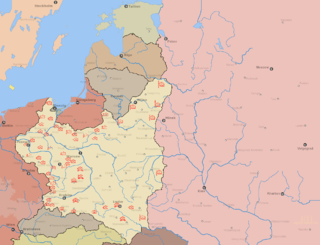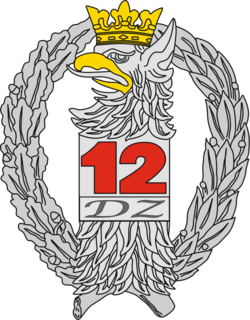
Stanisławów Voivodeship was an administrative district of the interwar Poland (1920–1939). It was established in December 1920 with an administrative center in Stanisławów. The voivodeship had an area of 16,900 km² and comprised twelve counties (powiaty). Following World War II, at the insistence of Joseph Stalin during Tehran Conference of 1943, Poland's borders were redrawn, Polish population forcibly resettled and Stanisławów Voivodeship was incorporated into the Ukrainian Soviet Socialist Republic as Stanislav Oblast.

This article discusses the Polish order of battle during the invasion of Poland. In the late 1930s Polish headquarters prepared "Plan Zachód", a plan of mobilization of Polish Army in case of war with Germany. Earlier, the Poles did not regard the Germans as their main threat, priority was given to threat from the Soviets.

The 7th Infantry Division was the name of several units of the Polish Army.
Polish 2nd Legions Infantry Division was a tactical unit of the Polish Army between the World Wars. Formed on February 21, 1919, in the towns of Zegrze and Jablonna near Warsaw, and composed mostly of veterans of the Polish Legions in World War I, the unit saw extensive action during the Polish-Bolshevik War and the Invasion of Poland.

The Polish 1st Tadeusz Kościuszko Infantry Division was an infantry division in the Polish armed forces formed in 1943 and named for the Polish and American revolutionary Tadeusz Kościuszko. Formed in the Soviet Union, it was the first division of the First Army, and of what later became the post-war Polish Armed Forces after defeating the Nazi regime and liberating Poland.

The 2nd Rifle Division was a Polish Army unit, part of the recreated Polish Army in France in 1940.
The 23rd Upper Silesian Infantry Division was a unit of the Polish Army in the interwar period (1921-1939). Created in 1921, its headquarters were stationed in Upper Silesian town of Tarnowskie Góry. Also, some other units were located in garrisons across the Polish part of Upper Silesia:
10th Infantry Division was a unit of the Polish Army during the interbellum period, which took part in the 1939 German Invasion of Poland. It was created in 1919 from the former Polish 4th Rifle Division. Stationed in Łódź and commanded in 1939 by General Franciszek Dindorf-Ankowicz, it was part of Łódź Army. Its task was to defend the fortified area along the upper Warta river, near the interwar border of Poland and Germany.
The 49th Hutsul Rifle Regiment was a unit of the Polish Army, which belonged to the 11th Carpathian Infantry Division. Stationed in the interbellum in the garrison in Kolomyja, it participated in the Polish September Campaign, fighting in southern Poland. It became famous after its night attack on parts of the German Independent Regiment SS-Standarte Germania.
Polish 3rd Legions Infantry Division was a tactical unit of the Polish Army between the World Wars. Formed in 1919, as a third unit composed significantly of veterans of the Polish Legions in World War I, it saw extensive action during the Polish-Bolshevik War and the Invasion of Poland. In the interbellum period, the headquarters of the division was stationed in Zamość, while its regiments were garrisoned in Chelm, Lublin, Zamosc and other locations.

The 9th Infantry Division was a unit of the Polish Army in the Second Polish Republic. For most of 1919, the 9th Division's regiments were dispersed across the regions of Podlachia, Polesie and Volhynia, with one battalion sent to Dąbrowa Basin.

The 12th Bolesław KrzywoustySzczecin Mechanised Division is a division of the Polish Armed Forces, headquartered in Szczecin.
The 36th Reserve Infantry Division was a unit of the Polish Army in the interbellum period, which took part in the Polish September Campaign.

Holosko Welyke was a village in Lwów Voivodeship, eastern Poland, before the Nazi German and Soviet invasions of Poland in September 1939. It is now a suburb of Lviv, Ukraine.

Polish 24th Infantry Division was a unit of the Polish Army in the interbellum period, which took part in the Polish September Campaign. The Division was created in 1921, and its first commandants were: General Jan Hempel, General Wacław Scaevola-Wieczorkiewicz, Colonel Boleslaw Maria Krzyzanowski, and Colonel Boleslaw Schwarzenberg-Czerny. The 24th Division's headquarters were located in Jarosław, with some regiments stationed in nearby cities of Rzeszów and Przemyśl. It consisted of:
During the Polish–Soviet War fought from February 1919 to March 1921 between Soviet Russia and the Second Polish Republic – after the conclusion of World War I in Europe – the Polish order of battle included broad disposition of personnel, strength, organization, and command structure.

The 41st (Reserve) Infantry Division was a tactical unit of the Polish Army during the early stages of World War II.
35th Infantry Division was a reserve unit of the Polish Army in the Second Polish Republic. It did not exist in peacetime organization of the army, and was formed between August 31 - September 4, 1939, during the Invasion of Poland.
The Battle of Czarnobyl took place on April 27, 1920, near the town of Chernobyl, Ukraine, during the Polish-Soviet War. It was part of the Kiev Operation of the Polish Army, and it ended in Polish victory.









